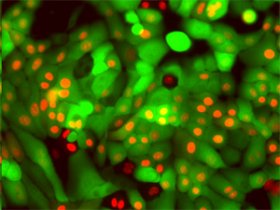ROS oxidative stress
 Scientists at PNNL are studying the signal transduction pathways involved in radiation and oxidative stress. Using retroviral techniques, live human mammary epithelial cells (HMEC) have been tagged with a green fluorescent probe for the protein, mitogen-activated protein kinase (MAPK). Using fluorescent microscopy, the movement of tagged proteins in response to stimuli, such as radiation, can be tracked in real time. Cell nuclei are shown in red.
Scientists at PNNL are studying the signal transduction pathways involved in radiation and oxidative stress. Using retroviral techniques, live human mammary epithelial cells (HMEC) have been tagged with a green fluorescent probe for the protein, mitogen-activated protein kinase (MAPK). Using fluorescent microscopy, the movement of tagged proteins in response to stimuli, such as radiation, can be tracked in real time. Cell nuclei are shown in red.
Oxidative stress describes cell damage caused by an overabundance of oxidants, including reactive oxygen species (ROS, e.g., oxygen ions, free radicals, and peroxide). ROS are harmful in excess, but some level of them is necessary for important cellular functions. Some cells produce ROS to kill invading microbes, and ROS are involved in cell signaling (1). Also, oxidative stress plays a role in cellular processes, such as aging and apoptosis.
In a balanced cell state, ROS are produced as a byproduct of metabolic processes and the level of ROS can be controlled with antioxidants, such as small molecular weight dietary supplements, including vitamin E and vitamin C; small molecular weight peptides and cofactors, including glutathione and pyruvate; and enzymes, including superoxide dismutase and catalase (2). In a state of cellular imbalance, in which the levels of oxidants outweigh the levels of antioxidants, damage is caused to nuclear and mitochondrial DNA, proteins, and lipids. If this damage is irreparable, then injury, mutagenesis, carcinogenesis, accelerated senescence, and cell death can occur (2). Oxidative stress has been linked to diseases, including some allergic and inflammatory skin diseases (3), Alzheimers (4), atherosclerosis in diabetes patients (5), and Lou Gehrig disease (6).
A state of oxidative stress can be induced by a number of factors, including chemical agents and radiation. Radiation-induced damage and oxidative stress are closely tied. Irradiated cells produce damaging ROS. Treatment with antioxidants can dampen the detrimental effects of radiation exposure (2). Cytoplasmic irradiation can result in damage to nuclear DNA, and experiments with free radical scavengers have shown this DNA damage is dependent on ROS generation (2, 7).
Evidence suggests that a cell’s oxidative state not only plays a role at the time of radiation exposure, but also has effects long after exposure. As the result of irradiation, cells can produce ROS for several minutes or even hours after being exposed (2). In addition to ROS production, cells are stimulated to increase their expression of antioxidants (2). This abundance of antioxidant defenses may play a role in the radioadaptive response (2), defined as the triggering of cellular effects upon radiation exposure that protect a cell when exposed to a subsequent radiation challenge.
You might also like







